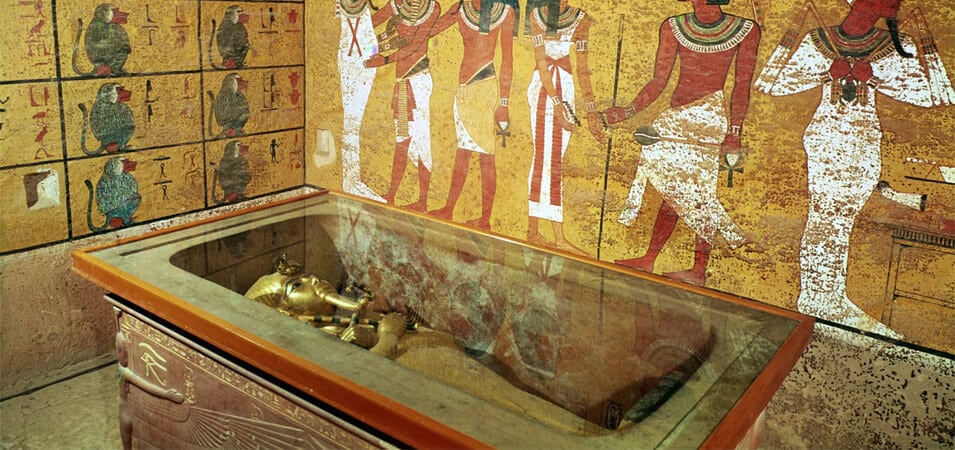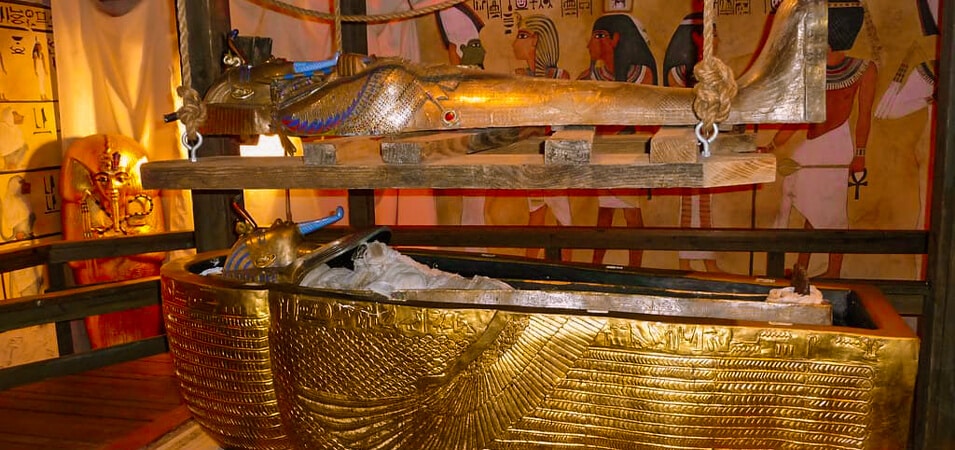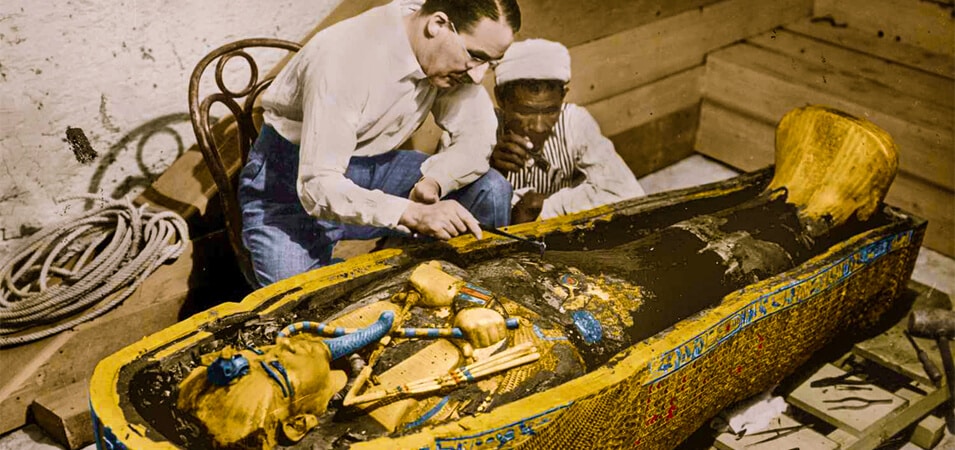The Tutankhamun’s Tomb, also called King Tut’s Tomb, is one of the most famous historical finds of the 20th century. This ancient burial place in Egypt’s Valley of the Kings is significant in history and culture. In this piece, we’ll look at the exciting story of how the tomb was found, what was inside it, and how that has changed our understanding of ancient Egyptian culture.
Book Our Egypt Vacation Packages
The Discovery of Tutankhamun’s Tomb
The discovery of how Tutankhamun’s tomb was found in 1922 is fascinating. Howard Carter, a famous British archaeologist, found the opening to the tomb by accident in Egypt’s Valley of the Kings. This important find showed where the young king Tutankhamun, who ruled in the 14th century BC, was laid to rest. Carter carefully explored and dug up the tomb. He found a treasure trove of items and treasures that taught him a lot about ancient Egyptian history and culture. The finding of Tutankhamun’s tomb is still a big deal in archaeology. It sparked worldwide interest and helped us learn more about this ancient culture.

The Curse of the Pharaohs
The Curse of the Pharaohs is a myth about the tombs of the pharaohs of ancient Egypt. Folklore says that whoever disturbs the graves of these pharaohs will face a curse that will bring them bad luck, illness, or even death. The idea of the curse captivated people all over the world, adding a sense of wonder and intrigue to the search for ancient tombs. But it’s important to remember that the curse is mostly just a false belief. Many people think the claimed curse was exaggerated to get attention. Still, the Curse of the Pharaohs continues to be exciting and a topic of discussion regarding the history and archaeology of ancient Egypt. One of the most exciting things about Tutankhamun’s tomb is the story of the “Curse of the Pharaohs.” People used to believe that anyone who messed with the grave of an old Egyptian pharaoh would be cursed and suffer bad luck or even die. Even though the curse has been proven to be a myth, it added to the mystery and appeal of the finding.
Don’t Miss To Read our articles about :
- 10 Things That Will Surprise You About Traveling To Egypt
- Best Places to Visit in Luxor and Aswan
- Exploring the Magic of Christmas in Egypt: A Guide for Travelers
- Gifts to Buy From Egypt: Unveiling the Treasures of Ancient Craftsmanship
- The Best Places to Visit in Egypt: Unraveling the Riches of Ancient Civilization
- Tips for the Best Nile Cruises in Egypt Christmas
Exploration and Excavation of Tutankhamun’s Tomb
Tutankhamun’s tomb was dug and explored with great care and commitment. Carter and his team worked for several years to carefully remove layers of dirt and reveal the hidden chambers inside the tomb. Every step of the excavation process was done with great care so that the items and the site would not be damaged. They found an old treasure chest full of amazing things as they entered the tomb. Each room showed something new about Tutankhamun and ancient Egyptian life and ideas. Every new find, from the detailed artwork on the walls to the beautiful burial artifacts, added to the awe and curiosity about this fantastic find. Exploring and digging up the tomb took hard work and knowledge to determine what the hieroglyphs and symbols meant. Archaeologists, researchers, and other experts worked to determine what the tomb’s walls hid.
The Contents of the Tutankhamun’s Tomb
The contents of Tutankhamun’s tomb were nothing short of astonishing. The rooms were full of riches, artifacts, and clues about how the ancient Egyptians lived and what they believed.
Let’s look at some of the fantastic things that were found in the tomb:
Chamber of Treasures: This room held a tremendous collection of items that showed how well ancient Egypt could make things. The room was filled with jewelry, statues, chariots, and other valuable things that showed how rich and talented people were at the time.
Burial room: The burial room was in the middle of the tomb. It was where Tutankhamun’s sacred remains were kept. It was carefully decorated and had a lot of religious and cultural meaning. On the walls were detailed drawings of scenes from the afterlife and paths the pharaoh could follow to get to the next world.
Sarcophagus and Coffins: The burial room had a beautiful casket and a set of coffins that fit inside each other. The mummified body of Tutankhamun was kept in these cases, which were made with great care and decorated with valuable things. Each coffin added a layer of safety and showed off the ancient Egyptians’ skill as artists.
Funeral Mask: The funeral mask of Tutankhamun is a masterpiece of ancient Egyptian art. It is one of the most famous things in the world. The face of the mummified king was covered by a mask made of solid gold and set with precious stones. It showed the beauty and royal glory of the ruling class.
Canopic Shrine: Inside the tomb, four canopic jars were found in a canopic shrine. Ancient Egyptians thought the organs of the pharaoh were necessary for the future, so they kept them in these jars. The deep respect and careful planning that went into the pharaoh’s burial can be seen in the patterns and craftsmanship of these containers.
Furniture and Personal Items: The tomb also had a wide range of furniture and personal items that were very interesting. Chariots, thrones, musical instruments, and even board games were found, which showed how Tutankhamun lived and what he did for fun.

Significance and Historical Importance of Tutankhamun’s Tomb
The finding of Tutankhamun’s tomb is significant to our understanding of ancient Egyptian culture and history. Here are some of the most important things that make this historical find so fascinating:
Insights into Life in Ancient Egypt The tomb of Tutankhamun showed more than ever before how ancient Egyptians lived, what they believed, and how they did things. The artifacts and treasures found in the tomb give us information about their religion, death rites, craftsmanship, and everyday life.
How to keep art and artifacts in good shape: The things in the tomb were very well preserved, making it possible to study ancient Egyptian art in its natural setting for the first time. The detailed carvings, paintings, and carefully made objects tell us a lot about how art was made then, what it meant, and what people liked to look at.
The Secret of Tutankhamun’s Tomb: Tutankhamun was a king of the 18th dynasty who was not very well known before his tomb was found. On the other hand, his tomb showed the luxury and wealth of a pharaoh, which raised his position and reigned in ancient Egyptian history. The tomb showed how important Tutankhamun was and sparked interest in his rule and the political situation at the time.
Effects on the Study of Archaeology and Egyptology: The careful digging and recording of Tutankhamun’s tomb set new standards for archaeologists’ work. It set a standard for future archaeological work and showed the importance of keeping objects in good shape, recording them carefully, and looking at them deeply.
Public Interest and Knowledge of the World: The finding of Tutankhamun’s tomb drew the attention of the whole world and made many people interested in ancient Egypt. The treasures from the tomb have been shown in museums worldwide, bringing in millions of tourists and making people more interested in ancient cultures.
Don’t Miss reading our articles about:
- Discover Egypt’s Holy Family Trail: Unveiling Sacred Destinations
- Discover Egypt’s Ramadan: Customs and Celebrations
- Ultimate Guide: Planning a Trip to Egypt – Top Tips & Attractions
- Discover Egypt’s Stunning National Parks: Nature’s Beauty
Importance in terms of education and culture:
The tomb of Tutankhamun has become a place where researchers, scholars, and people from all walks of life can learn about old Egyptian history. It has helped us know more about the Nile Valley’s rich cultural history and how it affected later civilizations. The importance of Tutankhamun’s tomb goes far beyond what it can teach us about ancient Egypt. It has become an enduring symbol of ancient Egypt’s grandeur, mysteries, and lasting legacy, capturing people’s imaginations worldwide and making them want to learn more about this fascinating culture and explore it further.
Conservation and Exhibition of Tutankhamun’s Tomb
After the tomb was dug up, a lot of work was done to save the things found in it. Many of these gems are on display at the Egyptian Museum in Cairo today. They have also been shown in museums worldwide, where their beauty and historical importance have wowed people.

Conclusion
The Tomb of Tutankhamun is a reminder of how great and beautiful old Egyptian culture was. It’s a window into the past that lets us see the world of the pharaohs and what they thought about the future. The finding of this tomb has added to what we know about history, and people from all over the world are still interested in it.
